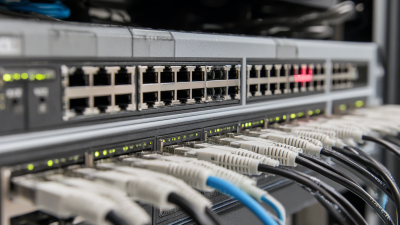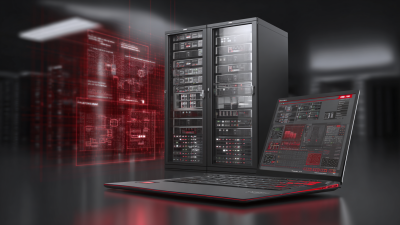Leave Your Message
In today's fast-evolving digital landscape, the role of Enterprise Switches has become paramount for organizations seeking to boost network performance and enhance security. According to industry reports from Gartner, the global enterprise networking market is projected to reach $50 billion by 2025, with enterprise switches accounting for a significant share due to their critical impact on data traffic management. Moreover, a study by IDC reveals that companies leveraging advanced switching technologies can improve their network efficiency by up to 30%, while also minimizing security risks associated with data breaches. These statistics underscore the necessity for businesses to invest in sophisticated enterprise switches not only to streamline operations but also to fortify their defenses against increasingly sophisticated cyber threats. As organizations strive for greater productivity and safety, understanding and unlocking the full potential of enterprise switches is essential for achieving these goals.

Next-generation enterprise switches are reshaping the landscape of network performance and security, particularly in their ability to maximize throughput. According to a recent report by the International Data Corporation (IDC), organizations that upgrade to these newer models can experience a remarkable increase in network efficiency, with reported throughput improvements surpassing 30%. This jump can significantly enhance data transfer speeds and reduce latency, enabling businesses to support more users and devices in their infrastructures without compromising performance.
The key to this impressive gain lies in advancements such as higher bandwidth capacities, better traffic management, and enhanced Quality of Service (QoS) features. For instance, next-gen switches often include support for multi-gigabit Ethernet and advanced Layer 3 routing capabilities, allowing for optimized data flow across complex networks. Furthermore, as per a study by Gartner, companies that adopt these technologies have not only reported improvements in their operational efficiency but also enhanced security measures, as modern switches integrate robust security protocols that safeguard against evolving threats. This dual focus on performance and security positions enterprise switches as essential components in the modern networking environment.
The integration of advanced switch features into enterprise networks significantly strengthens security protocols, a critical necessity as cyber threats become increasingly prevalent. With the rise of connected devices through the Industrial Internet of Things (IIoT), vulnerabilities within network infrastructure can be exploited, leading to severe repercussions for organizations. By effectively utilizing switches equipped with enhanced security functionalities, businesses can mitigate risks and bolster their defenses against unauthorized access and potential data breaches.

Moreover, as organizations transition to more sophisticated operational technology (OT) environments, the demand for robust network monitoring rises. This includes advanced threat detection capabilities that enterprise switches can provide, allowing for real-time responses to potential threats. As cybersecurity trends evolve, leveraging these tools not only protects critical infrastructure but also enables a proactive approach in addressing vulnerabilities before they are exploited. Integrating such features into existing networks is essential for maintaining resilience against a rapidly changing digital landscape.
Upgrading to high-performance enterprise switches can significantly enhance network performance and security, providing a compelling return on investment (ROI) for organizations. According to a recent report by the International Data Corporation (IDC), businesses that adopted advanced switching technologies reported up to a 30% reduction in network latency and a 25% increase in data throughput. These improvements are crucial for enterprises that rely on real-time data processing and sophisticated applications, as even minor delays can lead to considerable losses in productivity and revenue.
Furthermore, enhancing network security through high-performance switches is increasingly becoming a necessity. The Cisco 2023 Cybersecurity Threat Trends report highlighted that 70% of organizations experienced a security breach that originated from their network infrastructure. By deploying switches with advanced security features, such as integrated firewalls and intrusion detection systems, companies can mitigate these risks significantly. The same IDC report estimates that organizations can save up to 40% on potential breach recovery costs by investing in robust enterprise switching solutions, illustrating not just the operational, but also the financial prudence of such upgrades.
In today's data-driven landscape, effective traffic management is crucial for optimizing bandwidth usage and network performance. According to a report by Gartner, organizations can enhance network efficiency by up to 40% through the implementation of smart switching technologies. Enterprise switches equipped with advanced traffic management features allow for better prioritization of critical applications, ensuring that essential data flows seamlessly without congestion. This optimization not only improves user experience but also aids in maintaining service levels during peak usage.
Moreover, leveraging smart switching can significantly bolster network security. The IDC forecasts that by implementing intelligent switching solutions, businesses can reduce the risk of security breaches by over 30%. These switches facilitate the segmentation of network traffic, isolating sensitive information from general data flows. By employing techniques such as Quality of Service (QoS) and load balancing, organizations can adaptively manage bandwidth allocation, ensuring that both performance and security are prioritized. This dual focus on efficiency and protection is essential for enterprises looking to thrive in an increasingly complex network environment.
| Switch Model | Max Bandwidth (Gbps) | Ports | Layer Type | Smart Features | Security Features |
|---|---|---|---|---|---|
| Model A | 128 | 48 | Layer 3 | QoS, VLAN | ACL, IPsec |
| Model B | 64 | 24 | Layer 2 | Link Aggregation | 802.1X, DHCP Snooping |
| Model C | 512 | 96 | Multi-Layer | Dynamic Routing | DoS Protection, VPN |
| Model D | 256 | 48 | Layer 3 | Traffic Shaping | Identity Management, Firewall |
In today’s rapidly evolving technological landscape, organizations face significant scalability challenges as they strive to expand their network infrastructures.  Modular switching solutions provide a practical approach to address these growth requirements, enabling businesses to build future-proof networks that can adapt to increasing demands. By leveraging the latest advancements, such as high-capacity routers capable of handling multi-terabit processing, companies can ensure seamless data flow while enhancing overall network performance.
Modular switching solutions provide a practical approach to address these growth requirements, enabling businesses to build future-proof networks that can adapt to increasing demands. By leveraging the latest advancements, such as high-capacity routers capable of handling multi-terabit processing, companies can ensure seamless data flow while enhancing overall network performance.
Tips: When considering modular solutions, ensure that they offer compatibility with existing systems to facilitate smooth integration. Additionally, opt for switching technologies that support flexible expansion options, allowing your network to scale efficiently as needs change.
As demonstrated by recent developments in infrastructure, organizations like educational institutions are adopting high-speed smart campus solutions to support a growing number of Internet of Things (IoT) devices. This shift not only enhances connectivity but also ensures that security measures evolve in tandem with scaling needs, providing a robust framework for safeguarding valuable data.
Tips: Evaluate security features of modular switches to guarantee comprehensive protection against emerging threats. Regularly updating firmware and hardware components will also help maintain network integrity amid increasing traffic and potential vulnerabilities.






